Iridium availability is not a bottleneck to PEM electrolyser ramp-up; platinum demand from PEM electrolysers could reach >500 koz p.a. within 10 years
23 June 2023
Allaying market fears, we do not expect iridium supply to impede the roll out of PEM electrolyser capacity. Electrolyser capacity is forecast to expand from <1GW to ~4,000 GW by 2050 (IEA). PEM technology is expected to achieve a >30% market share, facilitating the transition to green hydrogen. Despite the use of critical metals, thrifting, recycling and viable substitution in other applications will result in iridium supply being sufficient to meet identified demand and support cumulative installed PEM capacity of 1,550 GW by 2050.
Iridium’s annual supply of ~250 koz is roughly in balance with existing demand. However, the scale of planned electrolysis growth implies that there will be substantial iridium deficits, assuming a >30% PEM market share and current loadings of 400 kg/GW. Indicatively, the ~20 GW of planned PEM commissioning in 2030 alone would require ~250 koz of iridium, consuming total annual supply. Considering iridium is ~20 times scarcer than platinum, a supply side response from PGM miners is impractical, therefore we highlight that substitution, thrifting and, recycling can address market fears of a perceived iridium bottleneck.
In Figure 1, overleaf, we provide a summary of iridium demand segments alongside feasible substitution options. Economic returns should drive substitution decisions, considering iridium prices have outperformed its sister metals over the past three years. The automotive (i.e. spark plugs) and electronics (i.e. crucibles) sectors are reportedly already substituting some iridium. Cumulatively, we estimate 20% of existing demand is substituted by 2030 and 30% by 2040, freeing up annual iridium supply of 45 koz to 67 koz over the next decade (see Fig. 2).
Improving technology (thrifting) will substantially reduce iridium demand from PEM electrolysers. The timing of demand is based upon Hydrogen Council projections.
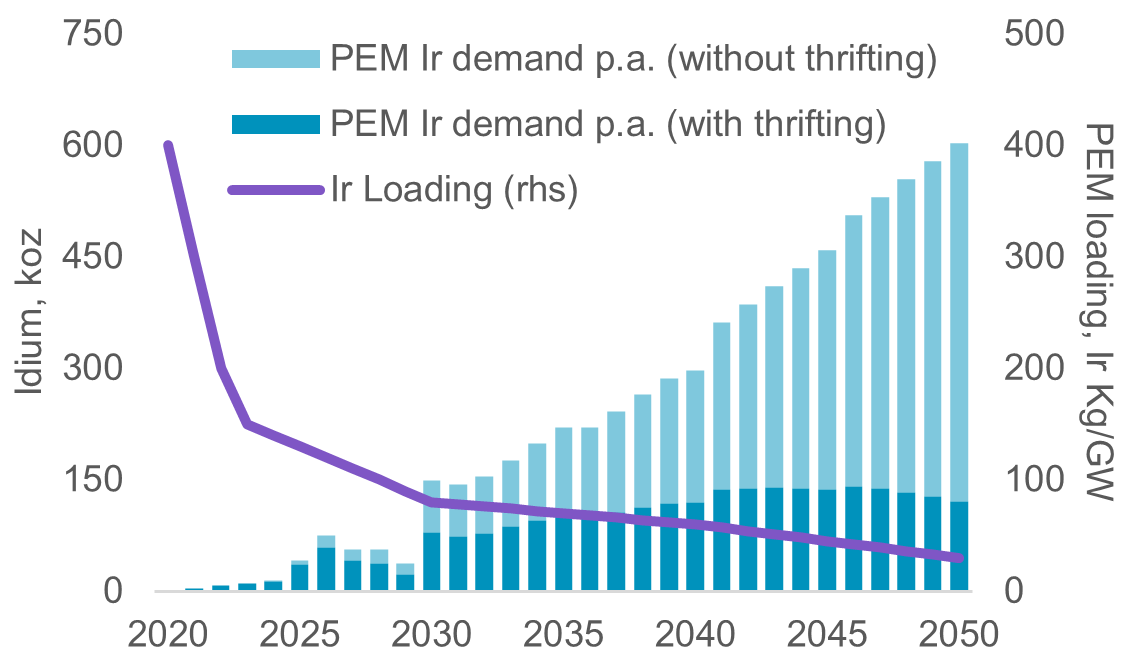
Cumulative iridium demand from PEM electrolysers is met in the next three decades, with 1.6 TW capacity by 2050.
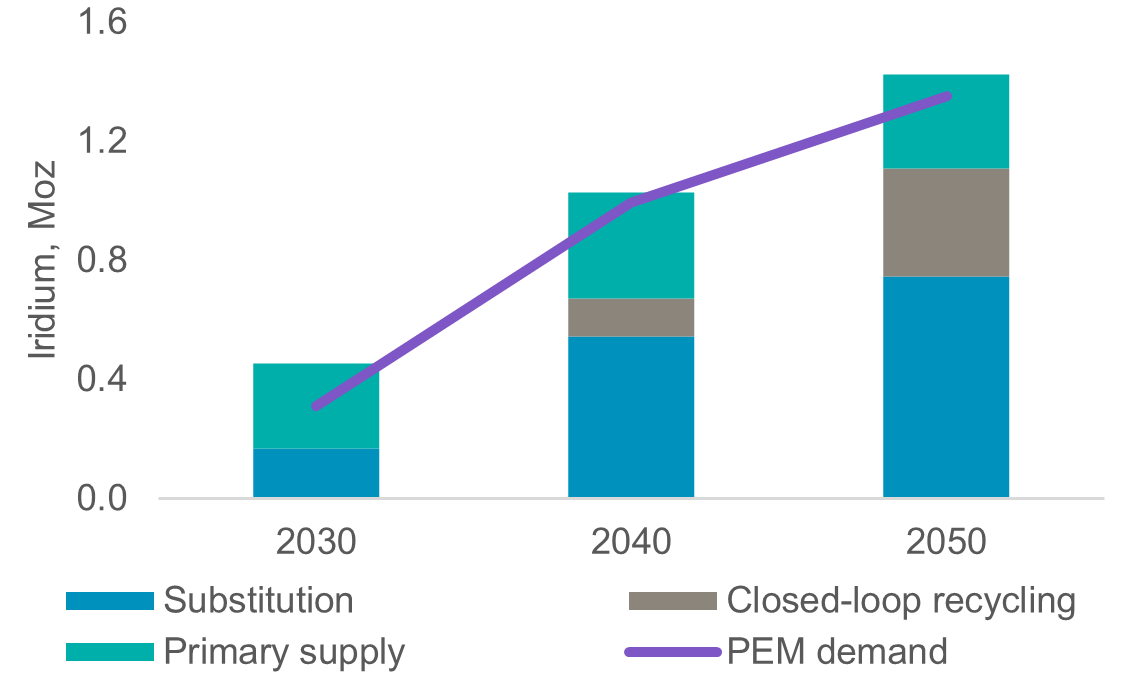
Iridium thrifting and design efficiency will underpin reductions in iridium loadings per installed gigawatt. OEMs are already pre-marketing 100 kg/GW catalysts, implying a 75% thrift. While thrifting will slow, Johnson Matthey believes 80 kg/GW loadings are feasible by 2030 and Heraeus cites the next generation of technologies is targeting further reduction of iridium loadings to 30 kg/GW by 2050.
Recycling is the third pillar necessary to meet iridium’s future demand needs. The US’s clean hydrogen roadmap targets a 99% recycling rate of PGMs within electrolysers by the 2030s. As spent catalysts are refreshed with more efficient designs (i.e. lower loadings), we illustrate in Figure. 4 that secondary iridium supply net of closed-loop replacements should occur from ~2030 (PEM electrolyser’s have a 7- to 10-year lifecycle). While some consecutive years of iridium deficits could arise from the mid-2030s, we estimate that recovering ~10% of non-PEM iridium from markets like spark plugs (at a 10-year lag) would sufficiently fulfill supply deficits. Nevertheless, evaluating cumulative iridium requirements over three ten-year periods to 2050, we believe the combination of substitution, thrifting and recycling will result in a balanced market, thereby preventing any bottlenecks. Accordingly, we estimate incremental platinum demand from PEM could reach ~500 koz per annum by the early 2030s.
Platinum’s attraction as an investment asset arises from:
- WPIC research indicates the platinum market entering a period of consecutive deficits from 2023.
- Platinum can be considered a proxy for investing in the growing hydrogen economy given its use in electrolysers and fuel cells.
- Platinum supply remains challenged, hampered by electricity shortages in South Africa and sanctions against Russia
- Automotive platinum demand growth should continue due principally to substitution in gasoline vehicles.
- The platinum price remains historically undervalued and significantly below both gold and palladium.
Figure 1: The tripling of iridium prices since 2020 (outperforming other PGMs) is incentivising substitution of iridium with other metals, with a number of opportunities to use alternative PGMs in current end uses.
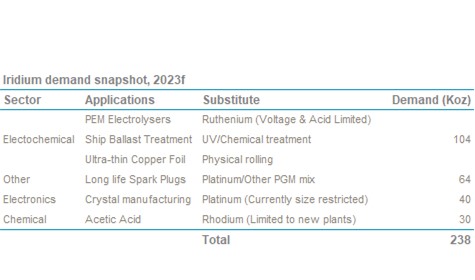
Figure 2: High iridium prices are resulting in substitution of iridium from traditional end uses, freeing up supply for PEM electrolysers. Substitution is expected to be possible for up to 30% of existing end use demand for iridium.
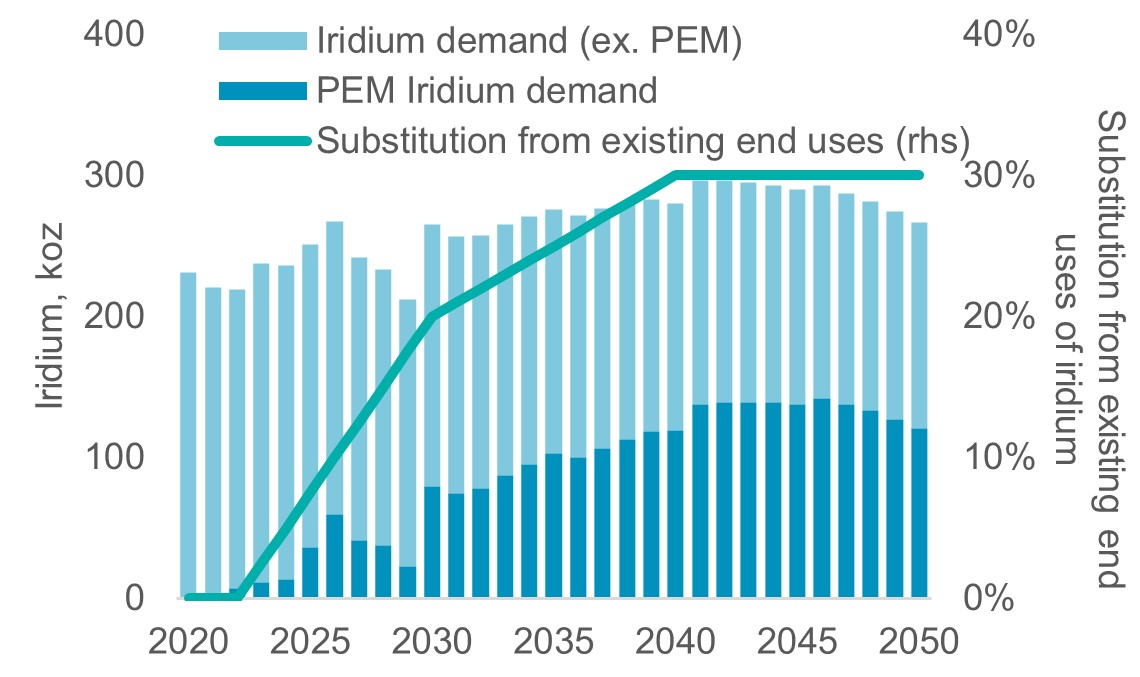
Figure 3: Developing more efficient technology (thrifting) will substantially reduce iridium demand from PEM electrolysers. The timing of demand is based upon Hydrogen Council projections for PEM electrolyser capacity additions.
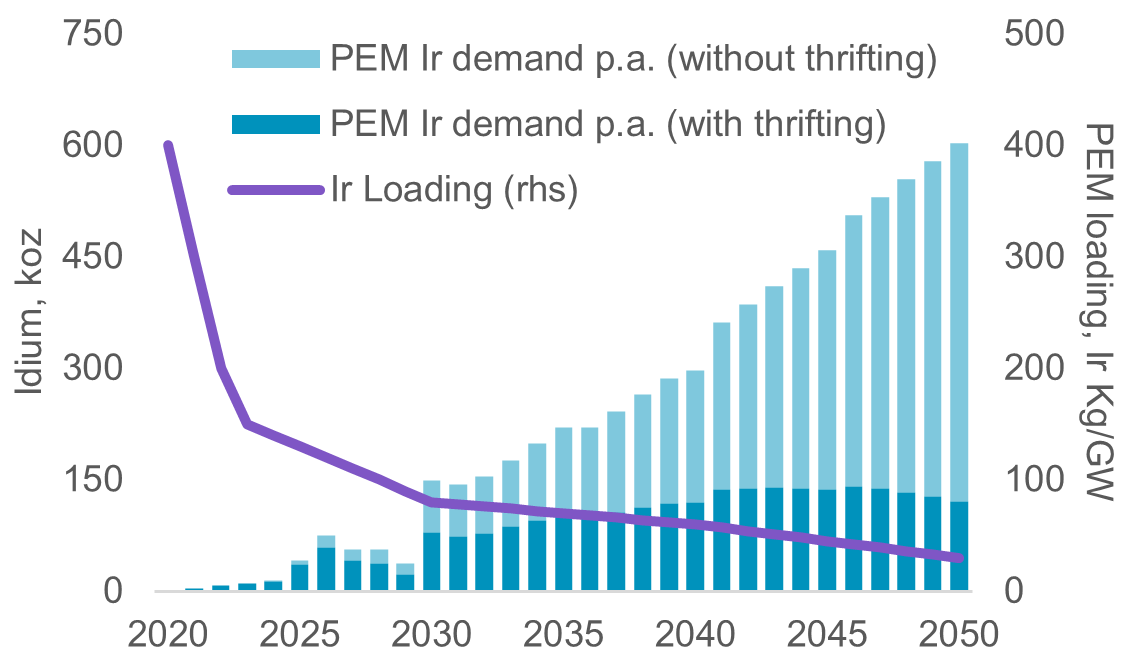
Figure 4: Less efficient catalysts are recycled with more efficient/lower loaded technology. Recovered iridium can be returned to the market, increasing supply.
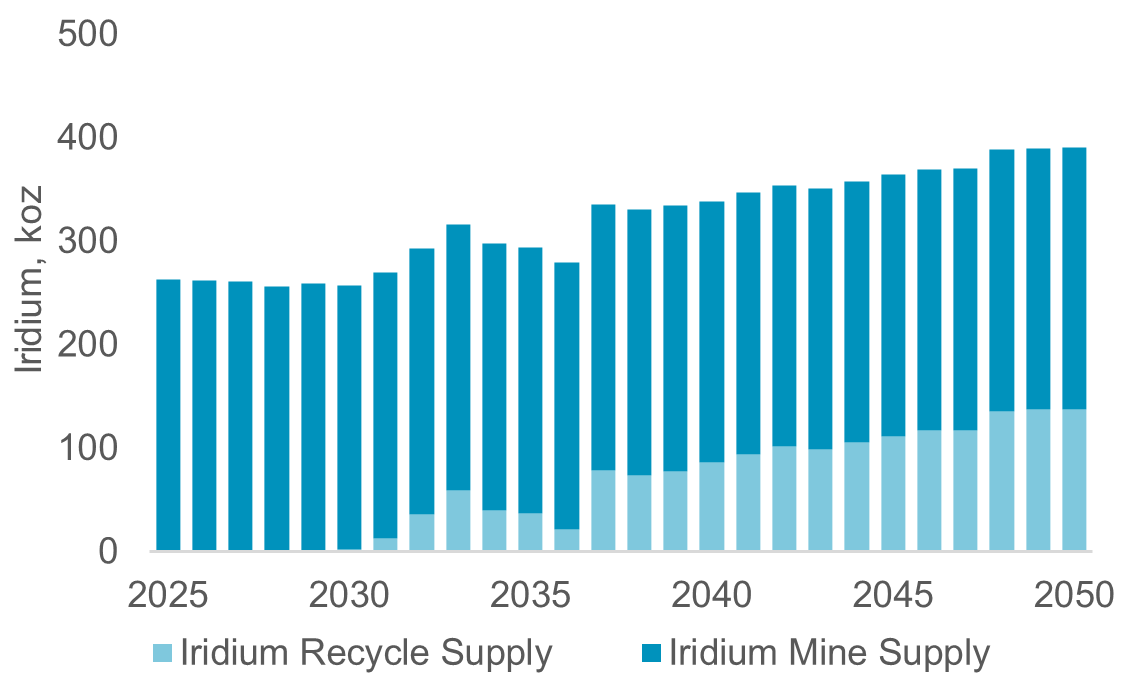
Figure 5: Cumulative iridium demand from PEM electrolysers is met in the next three decades, with 1,550 GW of projected capacity by 2050.
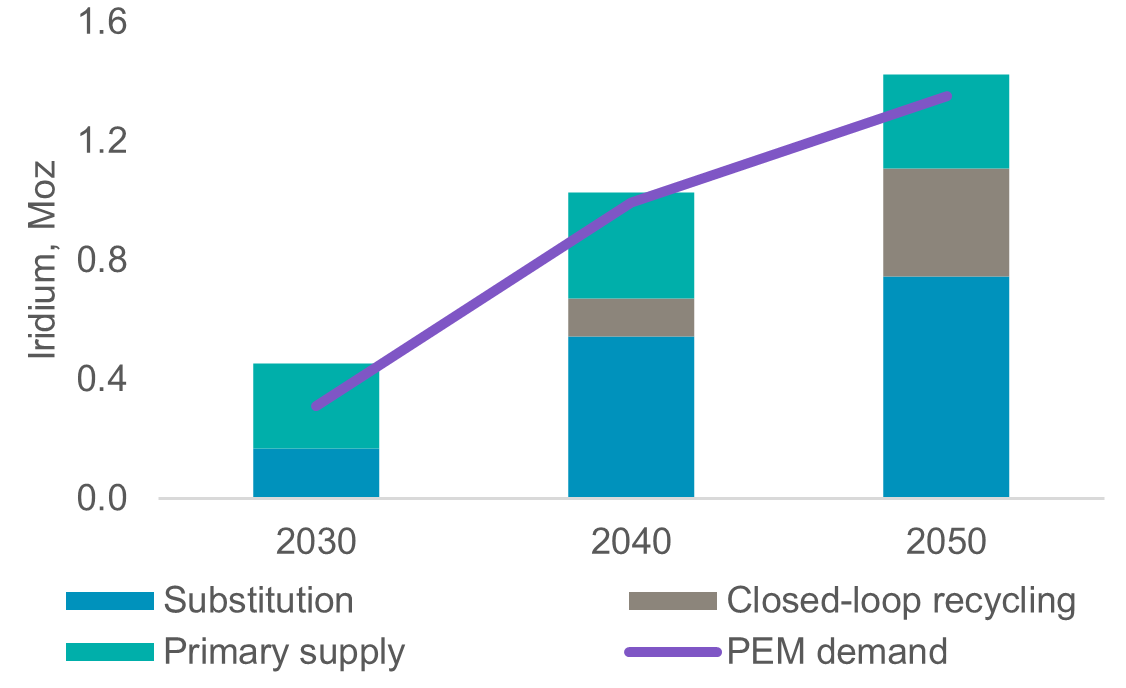
IMPORTANT NOTICE AND DISCLAIMER: This publication is general and solely for educational purposes. The publisher, The World Platinum Investment Council, has been formed by the world’s leading platinum producers to develop the market for platinum investment demand. Its mission is to stimulate investor demand for physical platinum through both actionable insights and targeted development: providing investors with the information to support informed decisions regarding platinum; working with financial institutions and market participants to develop products and channels that investors need.
This publication is not, and should not be construed to be, an offer to sell or a solicitation of an offer to buy any security. With this publication, the publisher does not intend to transmit any order for, arrange for, advise on, act as agent in relation to, or otherwise facilitate any transaction involving securities or commodities regardless of whether such are otherwise referenced in it. This publication is not intended to provide tax, legal, or investment advice and nothing in it should be construed as a recommendation to buy, sell, or hold any investment or security or to engage in any investment strategy or transaction. The publisher is not, and does not purport to be, a broker-dealer, a registered investment advisor, or otherwise registered under the laws of the United States or the United Kingdom, including under the Financial Services and Markets Act 2000 or Senior Managers and Certifications Regime or by the Financial Conduct Authority.
This publication is not, and should not be construed to be, personalized investment advice directed to or appropriate for any particular investor. Any investment should be made only after consulting a professional investment advisor. You are solely responsible for determining whether any investment, investment strategy, security or related transaction is appropriate for you based on your investment objectives, financial circumstances and risk tolerance. You should consult your business, legal, tax or accounting advisors regarding your specific business, legal or tax situation or circumstances.
The information on which this publication is based is believed to be reliable. Nevertheless, the publisher cannot guarantee the accuracy or completeness of the information. This publication contains forward-looking statements, including statements regarding expected continual growth of the industry. The publisher notes that statements contained in the publication that look forward in time, which include everything other than historical information, involve risks and uncertainties that may affect actual results. The logos, services marks and trademarks of the World Platinum Investment Council are owned exclusively by it. All other trademarks used in this publication are the property of their respective trademark holders. The publisher is not affiliated, connected, or associated with, and is not sponsored, approved, or originated by, the trademark holders unless otherwise stated. No claim is made by the publisher to any rights in any third-party trademarks
WPIC Research MiFID II Status
The World Platinum Investment Council -WPIC- has undertaken an internal and external review of its content and services for MiFID II. As a result, WPIC highlights the following to the recipients of its research services, and their Compliance/Legal departments:
WPIC research content falls clearly within the Minor Non-Monetary Benefit Category and can continue to be consumed by all asset managers free of charge. WPIC research can be freely shared across investment organisations.
- WPIC does not conduct any financial instrument execution business. WPIC does not have any market making, sales trading, trading or share dealing activity. (No possible inducement).
- WPIC content is disseminated widely and made available to all interested parties through a range of different channels, therefore qualifying as a “Minor Non-Monetary Benefit” under MiFID II (ESMA/FCA/AMF). WPIC research is made freely available through the WPIC website. WPIC does not have any permissioning requirements on research aggregation platforms.
- WPIC does not, and will not seek, any payment from consumers of our research services. WPIC makes it clear to institutional investors that it does not seek payment from them for our freely available content.
More detailed information is available on the WPIC website:
https://www.platinuminvestment.com/investment-research/mifid-ii
Contacts:
Edward Sterck, Research, [email protected]
Wade Napier, Research, [email protected]
Jacob Hayhurst-Worthington, Research, [email protected]
Brendan Clifford, Head of Institutional Distribution, [email protected]
WPIC does not provide investment advice.
Please see disclaimer for more information.
